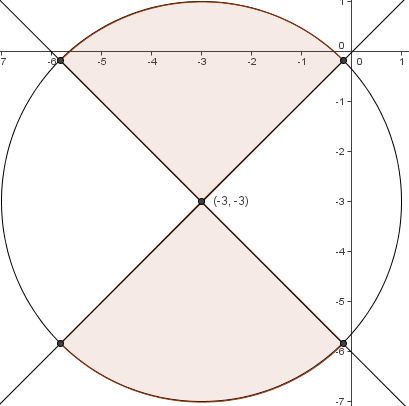Difference between revisions of "2002 AMC 12B Problems/Problem 25"
(soln) |
m (→Solution: center?) |
||
| Line 25: | Line 25: | ||
<cmath>x - y \le 0,\quad x+y+6 \le 0</cmath> | <cmath>x - y \le 0,\quad x+y+6 \le 0</cmath> | ||
| − | [[Image:2002_12B_AMC-25.png]] | + | [[Image:2002_12B_AMC-25.png|center]] |
Each of those lines passes through <math>(-3,-3)</math> and has slope <math>\pm 1</math>, as shown above. Therefore, the area of <math>R</math> is half of the area of the circle, which is <math>\frac{1}{2} (\pi \cdot 4^2) = 8\pi \approx 25 \Rightarrow \mathrm{(E)}</math>. | Each of those lines passes through <math>(-3,-3)</math> and has slope <math>\pm 1</math>, as shown above. Therefore, the area of <math>R</math> is half of the area of the circle, which is <math>\frac{1}{2} (\pi \cdot 4^2) = 8\pi \approx 25 \Rightarrow \mathrm{(E)}</math>. | ||
Revision as of 18:09, 16 January 2008
Problem
Let ![]() , and let
, and let ![]() denote the set of points
denote the set of points ![]() in the coordinate plane such that
in the coordinate plane such that
![]() The area of
The area of ![]() is closest to
is closest to
![]()
Solution
The first condition gives us that
![]()
which is a circle centered at ![]() with radius
with radius ![]() . The second condition gives us that
. The second condition gives us that
![]()
Thus either
![]()
or
![]()
Each of those lines passes through ![]() and has slope
and has slope ![]() , as shown above. Therefore, the area of
, as shown above. Therefore, the area of ![]() is half of the area of the circle, which is
is half of the area of the circle, which is ![]() .
.
See also
| 2002 AMC 12B (Problems • Answer Key • Resources) | |
| Preceded by Problem 24 |
Followed by Last problem |
| 1 • 2 • 3 • 4 • 5 • 6 • 7 • 8 • 9 • 10 • 11 • 12 • 13 • 14 • 15 • 16 • 17 • 18 • 19 • 20 • 21 • 22 • 23 • 24 • 25 | |
| All AMC 12 Problems and Solutions | |










